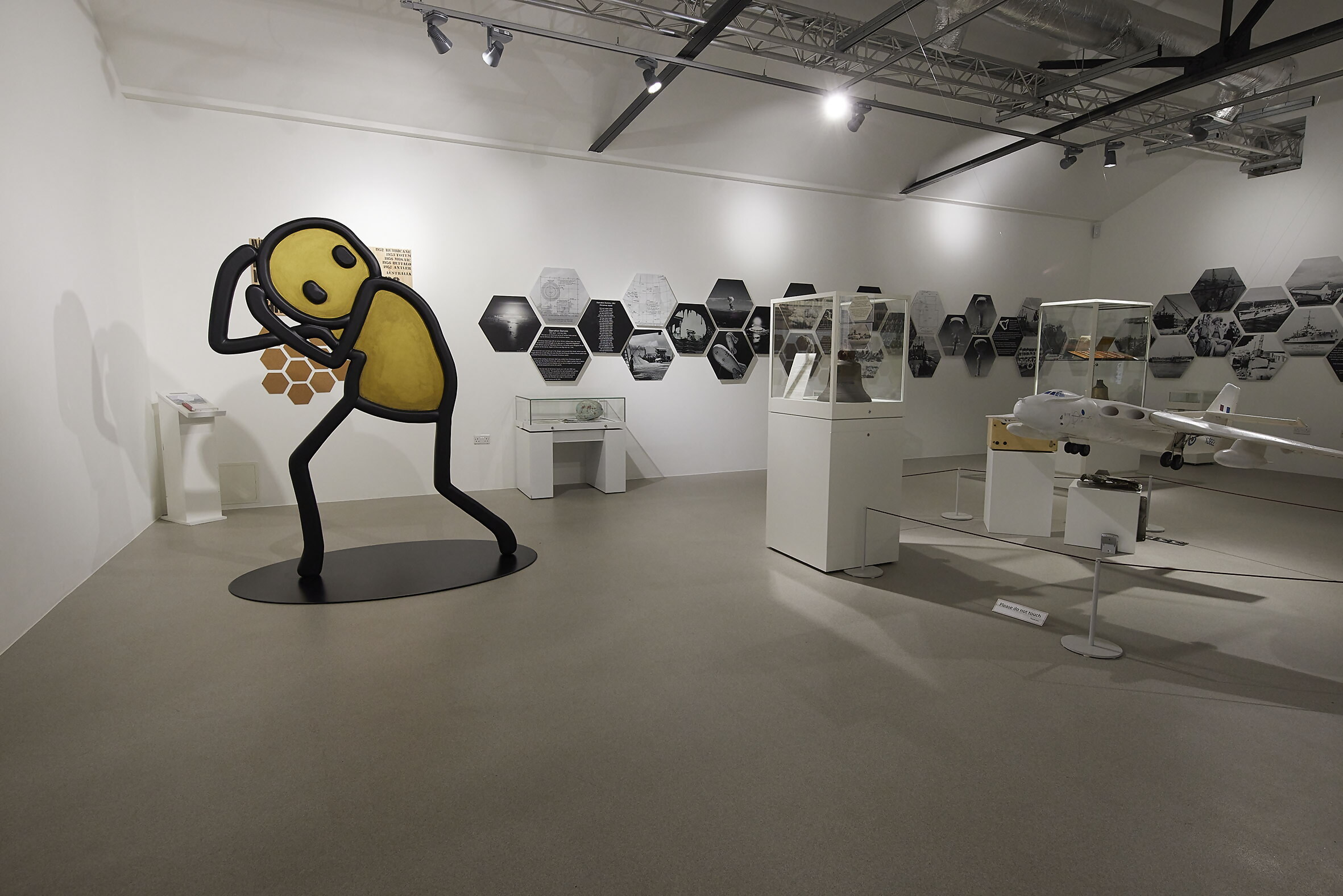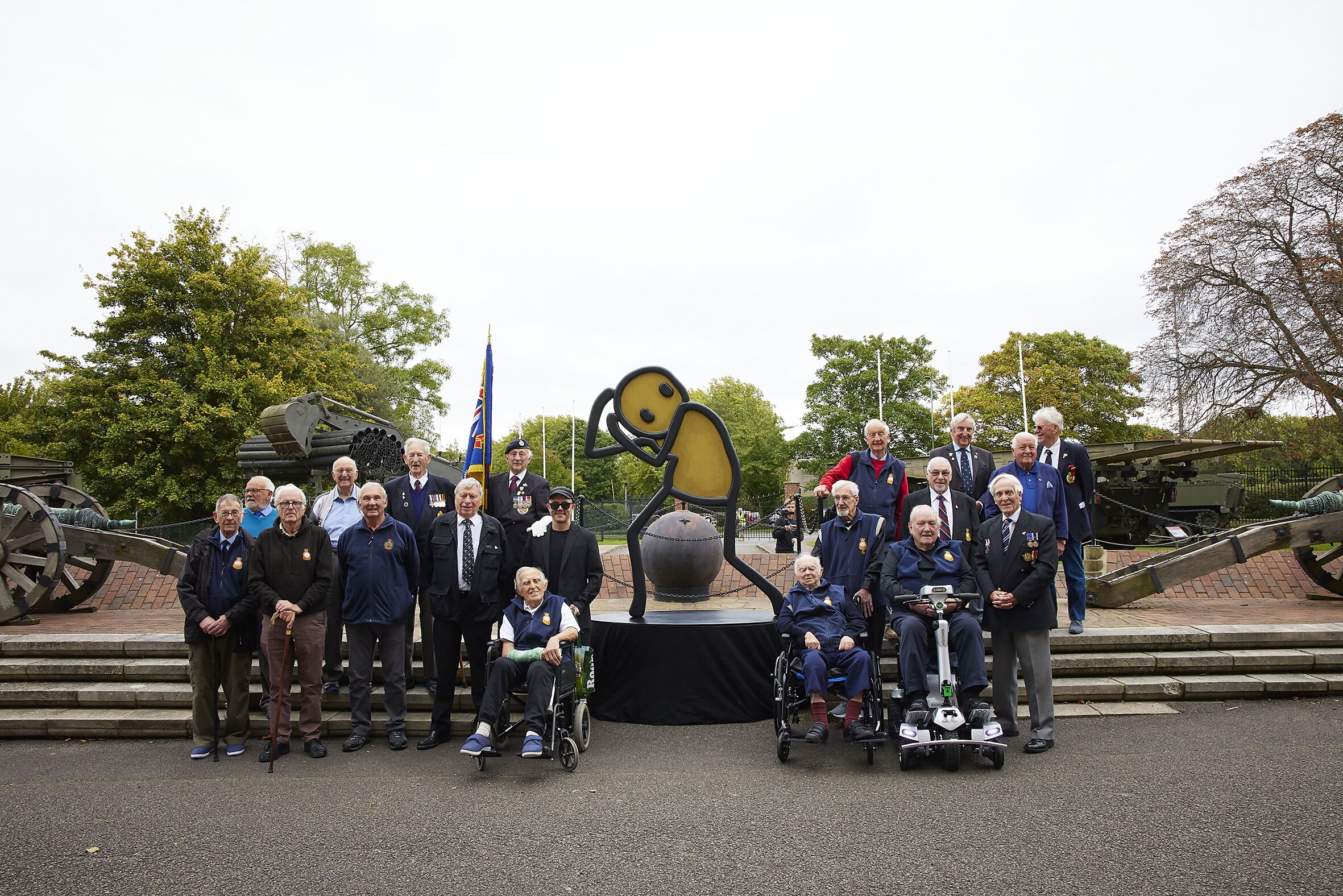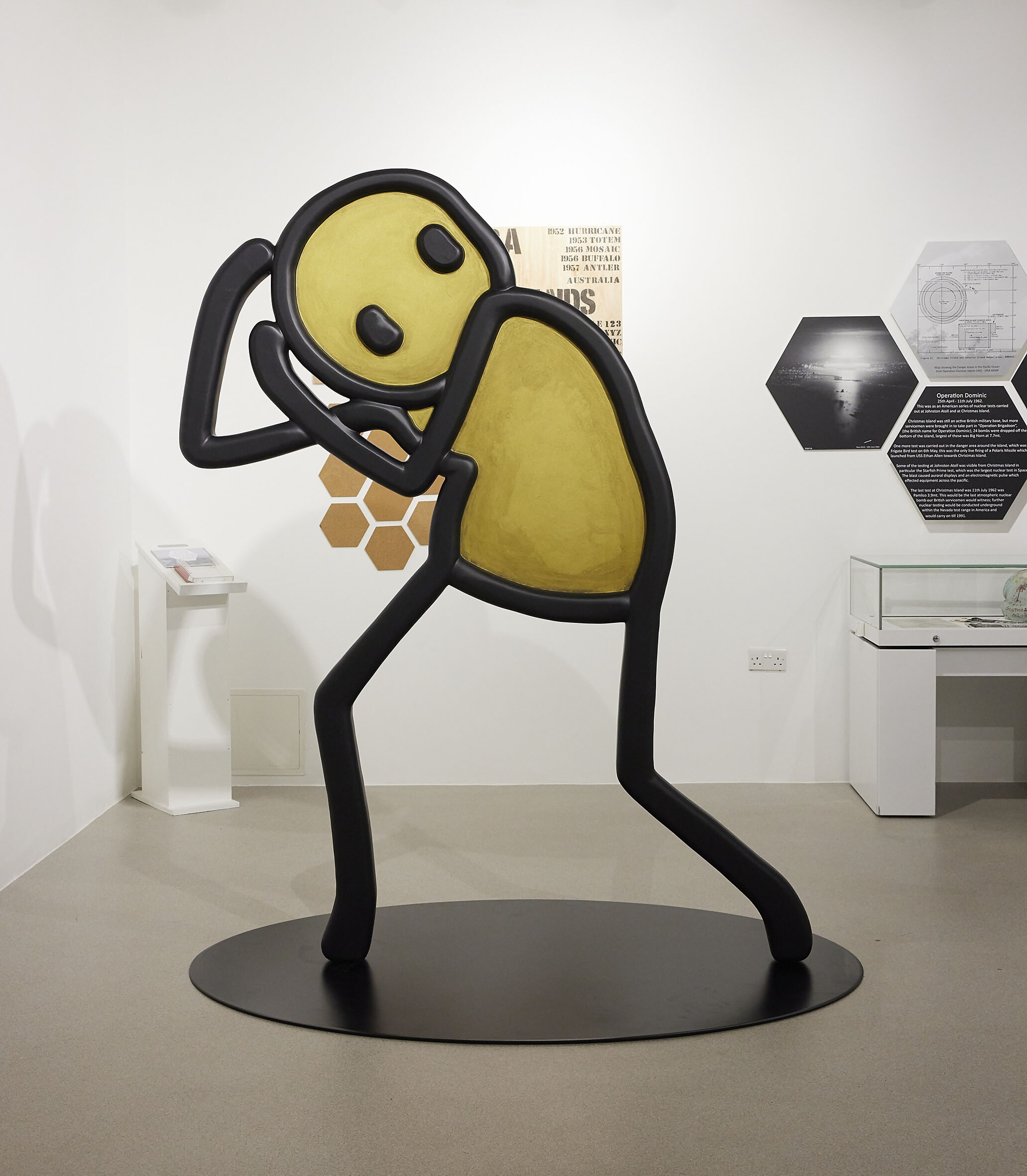
The story of Britain’s nuclear test veterans is horrific. They were forced to witness several atomic explosions without protective clothing, resulting in rare cancers and other diseases. The government ignored their plight for decades until last month’s promise of a medal – although this comes too late for the majority of those who were there.
The trouble is that many are simply unaware of this shameful chapter in British history. But an important new artwork from minimalist figurative painter and sculptor STIK aims to bring this tale to a new audience.

Image Credit: Jenny Lewis
STIK unveiled his working maquette of ‘Atomic’, a sculpture of a terrified, lone figure cowering from a nuclear explosion above, at the opening of the British Nuclear Test Veterans Association’s (BNTVA) exhibition at the Royal Engineers Museum in Gillingham, Kent, in October.
Speaking at the unveiling, the philanthropic artist, who has generated over £1million for organisations such as the NHS foundation, Big Issue and St Mungo’s homelessness charity, said: “When I learned of the first British nuclear tests, I read up every account I could find.
“After meeting (CEO) Ceri, I became a member of the British Nuclear Test Veterans Association and, at the annual conference, heard first-hand accounts from the veterans.
“I attended BNTVA meetings and met with veterans and their families and the more I listened, the more I felt the same visual motif emerging. The image of a young soldier, ordered to turn his back and cover his face against a nuclear blast was burned into my mind. This became the sole focus of my studio practice for the next 12 months.”
The ‘Atomic’ figure is bent double, arms clutched protectively over his head, eyes turned skyward, witnessing the unseen horror of a nuclear bomb for the first time. The body aligns with the points of the radiation hazard symbol hidden subliminally within the artwork.
The figure has been drawn to a child’s proportions, reminding us of the intergenerational effects of nuclear tests. It intends to evoke empathy. Looking back, wide-eyed directly at the bomb, the figure represents the lifting of secrecy. It is an unmistakable warning sign to future generations beyond language and culture.
The final sculpture will be cast in bronze and stand four metres tall, just like STIK’s best-known sculptural work, ‘Holding Hands’, in Hoxton Square, London.
Me & my mate Stik in Hoxton Square. He is the artisr who created this sculpture. pic.twitter.com/25DR5nCs7A
— lemn sissay OBE FRSL (@lemnsissay) September 26, 2020
But one big question remains – where will this culturally significant piece of artwork go once completed?
When we asked him this question at the unveiling of the maquette, STIK smiled and said: “It’s up to the veterans.
“Last year, I came to get their stories and to listen, and this year, I came to ask them where they want it.”
And the veterans and their descendants have plenty of ideas about where STIK’s latest creation could go. An animated brainstorming session resulted in a list of potential sites for Atomic, with many having strong links to Britain’s nuclear testing programme.
But there’s much to consider when trying to find a suitable location.
A suggestion of putting the artwork forward for the Fourth Plinth in Trafalgar Square was deemed a non-starter, as the following artworks to occupy the space have already been selected. Antelope by Samson Kambalu will occupy one of the highest-profile public art spaces in the world in 2022, while emoji 850 Improntas’ (850 Imprints) by Teresa Margolles will be installed in 2024.
The site of Britain’s first nuclear test – the Montebello Islands off the coast of Western Australia – was a popular suggestion, but the remote location means that the sculpture won’t be seen by many passing by – something crucial to bringing the plight of nuclear veterans to a new audience.
In terms of footfall, you can’t do better than a central London train station, with one, in particular, capturing the imagination of the veterans, many of whom would have passed through at some stage during their military service.
On his National Service when he was sent to Maralinga in South Australia for Operation Antler in 1957, Nuclear veteran Ed McGrath said: “There was a healthy debate about where the sculpture could be placed. I would like to see it at Kings Cross because the footfall would be enormous.” He added: “I’m grateful we have got someone like STIK interested in this.”
There is a precedent for other historically-important artworks on the London rail network, most notably Kindertransport – The Arrival, a bronze sculpture by Frank Meisler, located in the forecourt of Liverpool Street, which commemorates the 10,000 orphaned Jewish children who escaped Nazi persecution and arrived at the station during 1938–1939.
Sites in Portsmouth, Teesside and the London borough of Westminster were also suggested as potential homes for Atomic. Still, each would be subject to a successful planning application made to the relevant local authority.
And even with an international artist of STIK’s calibre at the helm, backed by an army of gritty and determined veterans, gaining planning permission isn’t a dead cert.
One of the more tongue-in-cheek suggestions was Downing Street, with Atomic acting as a constant reminder to the PM of what the government has put the veterans through.
But you can’t just apply to build a four-metre-tall sculpture on Rishi Sunak’s doorstep…or can you?
Under current UK planning law, anyone can make a planning application, regardless of who owns the land or buildings. Memorably, a disgruntled gran from Merseyside applied for planning permission to demolish the home of the then Tesco chief executive Sir Terry Leahy in protest against plans to bulldoze her home to make way for a new supermarket.

Image Credit: Jenny Lewis
It is not clear whether Downing Street is exempt from this rule, but the reality is such an application would never be granted anyway, making it nothing more than a publicity stunt – albeit one that would grab national headlines.
But wherever Atomic is eventually installed, the project has the overwhelming backing of the nuclear veteran community, who are pleased to have such a powerful voice speaking out on their behalf, keeping their stories alive and ensuring that those in power are never allowed to forget.
Ceri McDade, CEO of the BNTVA, said: “The veterans love it. And they are just happy that someone is working with them and understands how they feel. That somebody wants to push this publicly for people to see because the government is not doing enough to help them.”
The working maquette of Atomic will be on display at the Royal Engineers Museum in Gillingham, as part of the BNTVA’s Plym to Pamlico exhibition, until March 2023.


